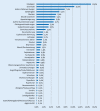[Three years of cannabis as medicine-preliminary results of the survey accompanying the prescription of medical cannabis in Germany]
- PMID: 33564897
- PMCID: PMC7932947
- DOI: 10.1007/s00103-021-03285-1
[Three years of cannabis as medicine-preliminary results of the survey accompanying the prescription of medical cannabis in Germany]
Abstract
In Germany, physicians who prescribe medical cannabis flowers or cannabis-based medicines (narcotic prescription) at the expense of the statutory health insurance are obliged to take part in a noninterventional accompanying survey that runs until 31 March 2022.At the time of this interim evaluation, 11 May 2020, there were 10,010 complete datasets collected. The most frequently treated symptoms were pain (73%), followed by spasticity (10%), and anorexia/wasting (6%). Dronabinol (i.e., prescription drug or Marinol®) was most frequently (65%) prescribed, followed by cannabis flowers (18%), Sativex® (13%), cannabis extract (4%, with increasing frequency), and nabilone (0.3%). The 6485 cases treated with dronabinol already allows a subgroup evaluation concerning efficacy. The typical cannabis side effects of tiredness, dizziness, dry mouth, and nausea occur with all cannabis medicines, and correspond to those already known from the product information of the cannabis-based medicinal products authorized under the pharmaceutical law. The potentially serious adverse effects of depression, suicidal ideation, delusions, hallucinations, dissociation, and misperceptions were each reported with a frequency higher than 0.1%. There were remarkable differences between patients treated with cannabis flowers and those with other cannabis medicines.Patients treated with cannabis flowers are significantly younger and predominantly male. They are treated more often by general practitioners and internists, their diagnosis differs more often from the typical diagnoses (pain, spasticity, anorexia/wasting), and they have more prior experience with cannabis. The underreporting in the accompanying survey is mainly in this patient group.
In Deutschland sind Ärztinnen und Ärzte, die Cannabisarzneimittel zulasten der gesetzlichen Krankenversicherung verschreiben, verpflichtet, an einer bis zum 31.03.2022 laufenden nichtinterventionellen Begleiterhebung zur Anwendung dieser Cannabisarzneimittel teilzunehmen.Zum Zeitpunkt der Zwischenauswertung am 11.05.2020 lagen 10.010 vollständige Datensätze vor. Am häufigsten wurden Schmerzen (73 %) als primär therapierte Symptomatik genannt, gefolgt von Spastik (10 %) sowie Anorexie/Wasting (6 %). Verordnet wurden in 65 % der Fälle Dronabinol (z. B. als Rezeptur oder Marinol® [AbbVie, IL, USA]), in 18 % Cannabisblüten, in 13 % Sativex® (GW Pharma, Cambridge, UK), in 0,3 % Nabilon (z. B. Canemes® [AOP Orphan Pharmaceuticals AG, Wien, Österreich]) und in 4 % (mit zunehmender Tendenz) Cannabisextrakt. Die Fallzahl von 6485 Fällen erlaubt bei Dronabinol bereits die Auswertung von Subgruppen hinsichtlich der therapeutischen Wirksamkeit. Für Cannabis typische Nebenwirkungen, wie Müdigkeit, Schwindel, Schläfrigkeit, Übelkeit und Mundtrockenheit, traten bei der Verwendung aller Cannabisarzneimittel auf und sind bereits aus den Fachinformationen der cannabisbasierten Fertigarzneimittel bekannt. Potenziell schwerwiegende Nebenwirkungen wie Depression, Suizidgedanken, Wahnvorstellungen, Halluzinationen, Dissoziation und Sinnestäuschungen sind in jeweils mehr als einem von 1000 Fällen gemeldet worden.Mit Cannabisblüten behandelte Personen sind deutlich jünger und weisen einen erheblich höheren Männeranteil auf. Sie werden häufiger hausärztlich behandelt (Allgemeinmedizin, innere Medizin), weichen häufiger von den üblicherweise behandelten Diagnosen (Schmerz, Spastik und Anorexie/Wasting) ab und verfügen über mehr Vorerfahrungen mit Cannabis. Das in der Begleiterhebung bestehende Underreporting betrifft diese Fallgruppe am stärksten.
Keywords: Indications; Interim evaluation; Medical cannabis; Prescription; Side effects.
References
-
- Verordnung über die Begleiterhebung nach § 31 Absatz 6 des Fünften Buches Sozialgesetzbuch (Cannabis-Begleiterhebungs-Verordnung – CanBV) vom 23. März 2017 (BGBl I S. 520)
-
- Sativex® (2015) Fachinformation https://www.fachinfo.de/suche/fi/013156 Zugegriffen: 30. September 2020
-
- Canemes® (2019) Fachinformation. https://www.fachinfo.de/suche/fi/021517 Zugegriffen: 30. September 2020
MeSH terms
Substances
LinkOut - more resources
Full Text Sources
Other Literature Sources
Medical





